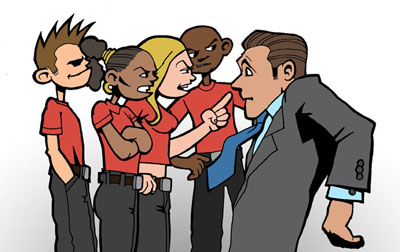Psychology tells us that we’re pretty good at sizing things up in the first few seconds. I’m sharing this because it has serious implications for school teachers.
We can learn a lot about someone in just 30 seconds; even more in 5 minutes; and after an hour we pretty much know how to act/react around someone. We know what things to say and not say, what things to do and not do.
One of the most difficult things about being a school teacher is learning how to stand up for yourself and the rules you believe in. In the social world we don’t “administer” consequences to our friends when they arrive late, forget to bring something, talk out of turn, or say something off-base. We might get mad at them, we might say something to them, we might stop being friends with them, but we don’t administer the kinds of consequences teachers have to administer when someone in their class breaks the rules. It’s entirely different.
When rules come before feelings and relationships – like in teaching – how we interact with people changes. And this requires us to change. And this change is one of the toughest lessons teachers have to learn. But it is vitally important.
If you start off as their best friend, they’ll treat you like a peer. They’ll love you at first and then laugh at you when you try to get serious … when you try to “pull rank.”
If you start off like a bully, they won’t like you … but they’ll never tell you they don’t like you, because they fear you … and then your students won’t learn anything.
If you start off timid, they’ll jump all over you. You might be able to regain control, but it will be difficult, and you’ll never get a second chance at making that first impression … which will linger despite your recovery.
If you never take a stand, they won’t know where you stand. They’ll likely walk all over you and what you believe in because … by not taking a stand … you let them.
But if you take a stand, right at the beginning, articulating your rules, your boundaries, and your expectations, which have to include, either implicitly or explicitly, that above all else everyone is to be respected and listened to – a rule all of us want and know is right – and you show them that you’re not afraid to administer consequences to those who violate the rules … When you show them this, when you take this stand in the first 30 seconds, 5 minutes, and hour of your time with them, they will know where they stand in relation to you.
And they’ll like it. They’ll respect you more for it. For setting boundaries. For letting them know where they stand in relation to you.
When respect is present, it holds steady because people gravitate towards it. They know it’s right.
But be careful: Disrespect can spread like wild fire. And if you don’t take a stand … well … you’re letting the winds of chance dictate what becomes of your classroom learning environment.
So take a stand.




